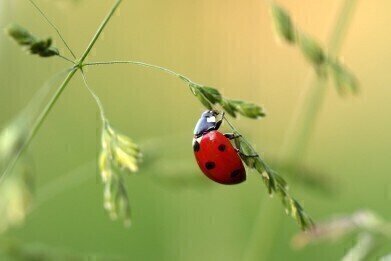GC, MDGC
Stinky Wine — A Ladybird Legacy?
Apr 28 2015
Gardeners and commercial growers share a common enemy — pests. Pests come in different shapes and sizes and infest crops and garden plants: Carrot Fly, Colorado Beetle and slugs and snails incur the wrath of plant growers the world over.
With increased awareness of environmental issues — including the damage pesticides might cause to the ecosystem in which they are used — growers are increasingly using natural methods of pest control to protect plants and crops. One of the natural methods used involves using predators, although this is not without its own problems as winegrowers have been finding out. Pour yourself a nice glass of Cabernet Sauvignon and read on about ladybirds, wine and aphids.
Natural Predators
One of the bugs people like to look at in their gardens are ladybirds, but they are a predator and useful to commercial growers including vignerons — people who grow grapes for wine. Ladybirds eat aphids, and whilst aphids are a nuisance for gardeners, they can be a serious pest for commercial growers. And the most voracious aphid eater is the harlequin ladybird from Asia.
An Alien Species
Farmers have tried to introduce the harlequin ladybird into the United States since early in the twentieth century to help combat aphids — but it took until late in the twentieth century for the alien invasion to be successful. The problem for vignerons is that as well as aphids, the harlequins love the taste of damaged grapes and come harvest time the ladybirds get mashed with the grapes. And this can cause a stink.
When the ladybirds are crushed they release blood from their leg sockets. The blood contains volatile, aromatic compounds which can spoil a batch of wine — meaning entire grape harvests have had to be destroyed due to the harlequin ladybirds.
Smelling bugs
Using chromatography, the compounds that the ladybirds released were analysed and over 30 different compounds identified. Four of the compounds belonged to the family methoxypyrazines — which is the same chemical family that help to generate the distinctive aroma of Sauvignon Blanc and Cabernet Sauvignon wines grown in the United States. So why the stink from the ladybirds?
The ladybirds released methoxypyrazines in different ratios and at different concentrations to those found in wines. To confirm that these were the chemicals contributing to the unpleasant aroma in wine, researchers used olfactory gas chromatography to separate the methoxypyrazines into pure form that the researchers could then ‘sniff’ as they exited the column. Read this article for more information about GC-O — Gas Chromatography or the Human Nose — Which Smells Better?
Even more surprising is the fact that there is a relationship between a ladybird’s colour and the quantity of methoxypyrazines it releases. Colour is partly genetic and partly nature as it depends on what food the ladybird larvae eat. But this offers growers a chance of predicting how their wine might be affected. Harlequin ladybirds have now reached Europe, and people are concerned about the effect they will have.
Glass of Chianti anyone?
Digital Edition
Chromatography Today - Buyers' Guide 2022
October 2023
In This Edition Modern & Practical Applications - Accelerating ADC Development with Mass Spectrometry - Implementing High-Resolution Ion Mobility into Peptide Mapping Workflows Chromatogr...
View all digital editions
Events
Apr 23 2024 Kintex, South Korea
Apr 23 2024 Seoul, South Korea
Apr 28 2024 Montreal, Quebec, Canada
May 05 2024 Seville, Spain
May 15 2024 Birmingham, UK














